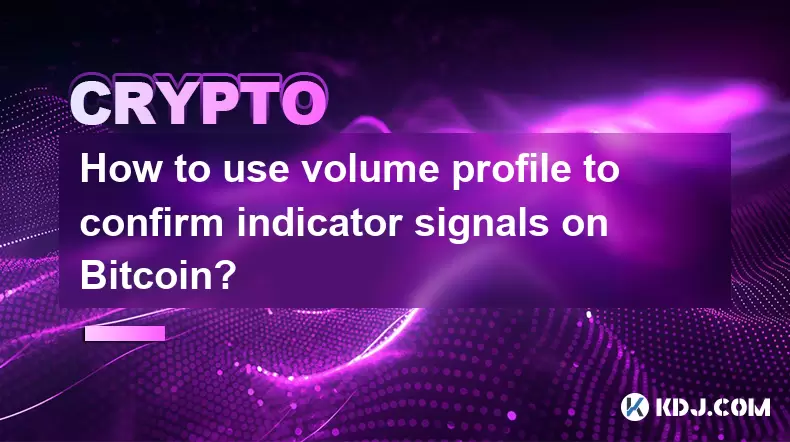-
 bitcoin
bitcoin $101752.865364 USD
-1.09% -
 ethereum
ethereum $3382.985899 USD
-1.38% -
 tether
tether $0.999658 USD
0.04% -
 xrp
xrp $2.272505 USD
-1.51% -
 bnb
bnb $989.089004 USD
0.14% -
 solana
solana $156.962612 USD
-3.08% -
 usd-coin
usd-coin $0.999776 USD
0.01% -
 tron
tron $0.290786 USD
-0.69% -
 dogecoin
dogecoin $0.174594 USD
-2.86% -
 cardano
cardano $0.560085 USD
-3.55% -
 hyperliquid
hyperliquid $40.023704 USD
-5.75% -
 chainlink
chainlink $15.324649 USD
-2.78% -
 bitcoin-cash
bitcoin-cash $493.576540 USD
-3.52% -
 zcash
zcash $571.320038 USD
-12.05% -
 stellar
stellar $0.280066 USD
-4.26%
How to use volume profile to confirm indicator signals on Bitcoin?
Volume profile helps Bitcoin traders identify key support/resistance levels by showing where significant trading volume occurred, enhancing decisions when combined with technical indicators.
Jul 05, 2025 at 07:43 pm

Understanding Volume Profile in Cryptocurrency Trading
Volume profile is a powerful analytical tool used by traders to understand the distribution of trading volume at different price levels. In the context of Bitcoin, it helps identify key support and resistance areas where significant buying or selling has historically occurred. The volume profile displays vertical bars on the side of a chart that represent how much volume was traded at each price level. This allows traders to see which prices have the most interest from market participants.
Volume profile provides insights into market structure and liquidity zones.
It’s particularly useful in cryptocurrency markets due to their high volatility and 24/7 trading nature. When analyzing Bitcoin, understanding where large volumes were transacted can help anticipate future price reactions.
Key Components of Volume Profile
To effectively use volume profile for confirming indicator signals, one must first understand its main components:
- Price Levels: These are horizontal lines indicating where significant trading activity took place.
- Point of Control (POC): The price level with the highest volume during the analyzed period.
- Value Area: Typically represents the range covering 70% of the total volume, showing where most trades occurred.
Each of these elements plays a crucial role in interpreting how Bitcoin might behave when approaching those levels again. For instance, if Bitcoin approaches a prior POC and an indicator like RSI shows overbought conditions, this could signal a potential reversal.
Integrating Volume Profile with Technical Indicators
Technical indicators such as RSI, MACD, and moving averages are commonly used in Bitcoin trading to generate buy or sell signals. However, these signals can sometimes be misleading without proper confirmation. That's where volume profile becomes essential.
Using volume profile alongside traditional indicators increases the reliability of trade setups.
For example, suppose the MACD line crosses above the signal line, suggesting a bullish trend. If this happens near a strong volume node identified via volume profile, the likelihood of a successful trade increases significantly. Conversely, if an indicator gives a bearish signal but Bitcoin is approaching a major value area, traders may question the validity of that bearish signal.
Step-by-Step Process to Confirm Indicator Signals Using Volume Profile
Here is a detailed process for confirming indicator signals using volume profile on Bitcoin charts:
- Select a time frame: Choose a chart interval that aligns with your trading strategy—daily for swing traders, hourly for day traders.
- Apply volume profile: Add the volume profile indicator to your charting platform and set the session or period you want to analyze.
- Identify key levels: Mark the Point of Control and Value Area boundaries clearly on the chart.
- Overlay technical indicators: Apply your preferred indicators (e.g., RSI, MACD) to the same chart.
- Look for confluence: Check whether any indicator-generated signals coincide with volume-heavy areas.
- Analyze recent behavior: Observe how Bitcoin reacted the last time it approached these levels with similar indicator readings.
By following this process, traders can filter out false signals and improve their decision-making accuracy when trading Bitcoin.
Practical Example: Confirming a Sell Signal with Volume Profile
Let’s consider a practical scenario where a trader uses the RSI indicator and volume profile together to confirm a sell signal on Bitcoin.
The trader notices that Bitcoin's RSI has moved above 70, indicating overbought conditions. Before acting on this alone, they check the volume profile and find that Bitcoin is approaching a previous resistance zone with heavy volume concentration. This zone had acted as a ceiling multiple times before.
When RSI indicates overbought and price meets a high-volume resistance level, the probability of a reversal increases.
In this case, the trader decides to short Bitcoin with a tight stop-loss just above the resistance level. They also monitor how volume reacts as Bitcoin approaches this level—if volume surges downward, it confirms the strength of the rejection.
Frequently Asked Questions
Q: Can volume profile be used on all timeframes for Bitcoin trading?Yes, volume profile can be applied to any timeframe. Short-term traders often use it on hourly or 15-minute charts, while long-term traders prefer daily or weekly charts to assess broader market sentiment.
Q: What platforms offer volume profile tools for cryptocurrency analysis?TradingView, Bybit, OKX, and some advanced versions of Binance Pro provide volume profile features. Ensure the platform supports futures data for more accurate readings since spot volume can be misleading due to wash trading.
Q: How does volume profile differ from regular volume bars?Regular volume bars show total volume per candlestick, whereas volume profile breaks down volume by individual price levels. This allows traders to pinpoint exact areas where the market has shown strong interest.
Q: Is volume profile reliable during low-liquidity periods in crypto markets?During low-liquidity phases, volume profile readings can be less reliable because fewer trades occur across price levels. Traders should use wider time windows or combine with other tools to enhance accuracy.
Disclaimer:info@kdj.com
The information provided is not trading advice. kdj.com does not assume any responsibility for any investments made based on the information provided in this article. Cryptocurrencies are highly volatile and it is highly recommended that you invest with caution after thorough research!
If you believe that the content used on this website infringes your copyright, please contact us immediately (info@kdj.com) and we will delete it promptly.
- Ripple (XRP) in 2026: Hold or Fold? A Look at XRP's Future and Emerging DeFi Alternatives
- 2025-11-08 18:35:01
- Zcash ZEC Coin Price Explosion: From Privacy Niche to Center Stage
- 2025-11-08 18:55:01
- Berachain Price Prediction: Navigating the Honeycomb Hype in Crypto
- 2025-11-08 18:55:01
- Arthur Hayes, Gold, and Bitcoin: A Modern Monetary Trinity?
- 2025-11-08 19:15:01
- Shiba Inu's Next Move: Navigating a Shifting Market
- 2025-11-08 19:20:01
- Pakistan's Crypto Crossroads: Balancing Opportunity with Asset-Backed Realities
- 2025-11-08 19:20:01
Related knowledge

What is the total supply of Bitcoin?
Oct 10,2025 at 01:55pm
Total Supply of Bitcoin1. The total supply of Bitcoin is capped at 21 million coins. This limit is hardcoded into the Bitcoin protocol and cannot be a...

Can you buy a fraction of a Bitcoin?
Oct 10,2025 at 06:01pm
Understanding Fractional Bitcoin Ownership1. Yes, you can buy a fraction of a Bitcoin. The smallest unit of Bitcoin is called a satoshi, which represe...

How to buy Bitcoin for the first time?
Oct 21,2025 at 11:00am
Understanding Bitcoin and Its Value1. Bitcoin is a decentralized digital currency that operates on a peer-to-peer network without the need for interme...

Why is Bitcoin considered a revolutionary technology?
Aug 12,2025 at 08:29pm
Decentralization and the Elimination of Central AuthoritiesThe core innovation behind Bitcoin lies in its decentralized architecture, which fundamenta...

Why is Bitcoin considered a revolutionary technology?
Aug 10,2025 at 07:42pm
Decentralized Architecture and Trustless TransactionsBitcoin is considered revolutionary because it introduced a decentralized architecture that opera...

What are the key features of Bitcoin?
Aug 10,2025 at 02:50am
Decentralization and Peer-to-Peer NetworkOne of the most defining characteristics of Bitcoin is its decentralized nature. Unlike traditional financial...

What is the total supply of Bitcoin?
Oct 10,2025 at 01:55pm
Total Supply of Bitcoin1. The total supply of Bitcoin is capped at 21 million coins. This limit is hardcoded into the Bitcoin protocol and cannot be a...

Can you buy a fraction of a Bitcoin?
Oct 10,2025 at 06:01pm
Understanding Fractional Bitcoin Ownership1. Yes, you can buy a fraction of a Bitcoin. The smallest unit of Bitcoin is called a satoshi, which represe...

How to buy Bitcoin for the first time?
Oct 21,2025 at 11:00am
Understanding Bitcoin and Its Value1. Bitcoin is a decentralized digital currency that operates on a peer-to-peer network without the need for interme...

Why is Bitcoin considered a revolutionary technology?
Aug 12,2025 at 08:29pm
Decentralization and the Elimination of Central AuthoritiesThe core innovation behind Bitcoin lies in its decentralized architecture, which fundamenta...

Why is Bitcoin considered a revolutionary technology?
Aug 10,2025 at 07:42pm
Decentralized Architecture and Trustless TransactionsBitcoin is considered revolutionary because it introduced a decentralized architecture that opera...

What are the key features of Bitcoin?
Aug 10,2025 at 02:50am
Decentralization and Peer-to-Peer NetworkOne of the most defining characteristics of Bitcoin is its decentralized nature. Unlike traditional financial...
See all articles





















![The Graph Price Prediction [GRT Crypto Price News Today] The Graph Price Prediction [GRT Crypto Price News Today]](/uploads/2025/11/07/cryptocurrencies-news/videos/690d4df44fe69_image_500_375.webp)




















































